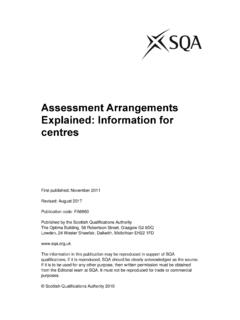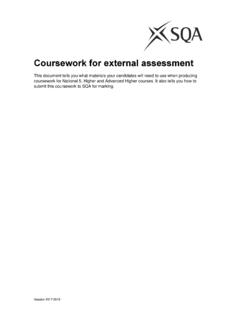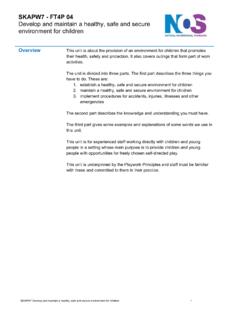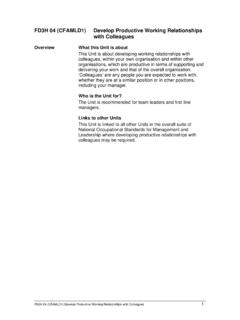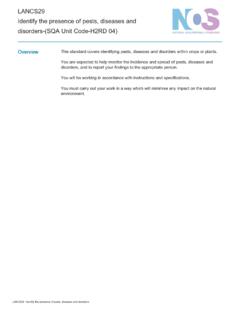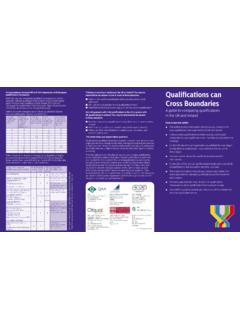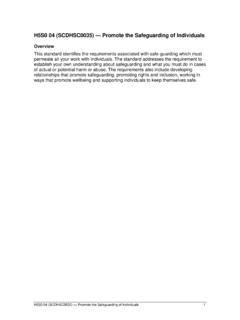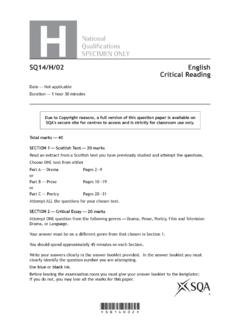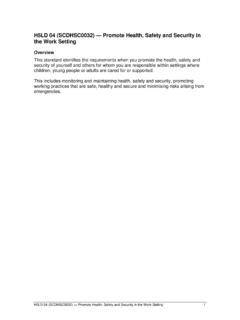Transcription of Physical Education Performance Assessment task - SQA
1 Physical Education Performance Assessment task Valid from session 2019 20 and until further notice. This edition: August 2019 (version ). The information in this publication may be reproduced to support SQA qualifications. This publication must not be reproduced for commercial or trade purposes. This material is for use by teachers and lecturers. Scottish Qualifications Authority 2012, 2019. Contents Introduction 1. Instructions for teachers and lecturers 2. Marking instructions 6. Recording documentation 11. Instructions for candidates 14. Introduction This document contains marking instructions, instructions for teachers and lecturers and instructions for candidates for the National 5 Physical Education Performance . It must be read in conjunction with the course specification. The performances have a total of 60 marks. The marks contribute 50% of the overall marks for the course Assessment . Each single Performance event is marked out of 30.
2 This is one of two course Assessment components. The other component is a portfolio. The purpose of this component is to assess candidates' ability to effectively perform in two different Physical activities. Each Performance will be a single event which is in a challenging, competitive and/or demanding context. This gives candidates an opportunity to demonstrate the following skills, knowledge and understanding: a repertoire of skills including complex skills control and fluency effective decision-making using and applying straightforward composition, tactics or roles safely and effectively conforming to rules, regulations and etiquette controlling emotions working co-operatively with others Version 1. Instructions for teachers and lecturers Each single Performance is: set by centres within SQA guidelines conducted under some supervision and control internally marked by centre staff in line with SQA marking instructions All marking will be quality assured by SQA.
3 Each Performance must be in a challenging, competitive and/or demanding context to set it apart from normal learning and teaching activities. Teachers and lecturers must ensure that they can reliably assess each candidate in any context. This will involve giving consideration to the number of candidates being assessed at any one time. The activity selected for each single Performance event must provide candidates with the opportunity to display a significantly different range of movement and Performance skills. This will allow them to demonstrate a breadth of Performance skills within a variety of contexts. Assessment conditions Time The performances should be of a sufficient duration to allow candidates to demonstrate the required skills, knowledge and understanding. Supervision, control and authentication Teachers and lecturers must ensure candidates are provided with a suitable Performance environment and appropriate conditions to undertake their assessments.
4 Teachers and lecturers should use their professional judgement as to whether the context is suitable. Performances must be authenticated as being carried out under the required Performance conditions and to the required standards. Resources There are no restrictions on the resources available to candidates. Reasonable assistance Candidates must undertake the Assessment independently. However, they may receive assistance with the selection of appropriate Physical activities prior to the Assessment taking place. Version 2. Evidence to be gathered Teachers and lecturers should use observational checklists to record candidate achievement for each Performance . These checklists can be found in this Performance Assessment task document. Teachers and lecturers must ensure that comments about how Assessment judgements have been made for each candidate are included on the checklists. Volume Candidates must complete two single performances in different Physical activities.
5 Acceptable activities for Assessment purposes Choosing activities There are no mandatory Physical activities. Physical activities that are suitable for Assessment are normally chosen from those covered as part of the course. Candidates should discuss and agree on the activity that they want to choose with their teacher or lecturer. Centres must ensure that teachers or lecturers have sufficient expertise to manage the Assessment process and to assess the candidates. Teachers and lecturers that do not have sufficient assessor expertise in a particular activity must not assess that activity. Activities must: require Physical fitness and draw on aspects of agility, balance, coordination, flexibility, reaction time, speed, strength and power require demand and/or competition in group or team activities or individual Performance require performers to make decisions and adapt to challenging situations require practice and a range of skills use large muscle groups and anaerobic or aerobic energy systems require effort and exertion allow candidates to be assessed against the Assessment criteria Version 3.
6 Acceptable activities and restricted combinations table The following table contains a selection of acceptable activities. Restrictions on certain combinations ensure candidates receive a broad experience. Please note this list is not exhaustive. Acceptable activity Restrictions on Assessment combinations Athletics (including Can only be used as one activity. Second activity cannot be cross country running) orienteering. Badminton Basketball Boxing Second activity cannot be martial arts or kickboxing. Canoeing Second activity cannot be kayaking or rowing. Cheerleading Second activity cannot be dance. Cricket Curling Cycling Can only be used as one activity. Dance Can only be used as one activity. Second activity cannot be cheerleading. Equestrian Can only be used as one activity. Football Golf Gymnastics (including Can only be used as one activity. trampolining). Handball Hockey Kayaking Second activity cannot be canoeing or rowing.
7 Kickboxing Second activity cannot be boxing or martial arts. Lacrosse Martial arts Can only be used as one activity. Second activity cannot be boxing or kickboxing. Netball Orienteering Second activity cannot be athletics (including cross country running). Rowing Second activity cannot be canoeing or kayaking. Rugby Can only be used as one activity. Shinty Skiing and Can only be used as one activity. snowboarding Swimming Can only be used as one activity. Squash Table tennis Tennis Volleyball If activities have a singles and doubles version, only one is acceptable. If activities have indoor and outdoor versions, only one is acceptable. Version 4. Unacceptable activities An activity is not acceptable if: it does not require a level of Physical fitness which directly affects the quality and sustainability of Performance it does not contain the interconnected holistic requirement of the four factors that impact on Performance it does not comprise depth, breadth or complexity of skills or technique, tactics and strategy, or compositional creativity it does not offer demand and/or challenge in group or team or individual Performance the effort, exertion or power is generated by a motor vehicle, for example karting, quad biking parts of activities have been merged to create a modified game, for example heady handball, tchoukball, Swedish longball it is a means of developing and maintaining fitness rather than an activity that meets the requirements of skills, tactics and compositional creativity, for example circuits, interval training, weight training, CrossFit, yoga.
8 Pilates the aim is to hit a target and the level of Physical fitness does not directly affect the quality and sustainability of Performance , for example darts, snooker, pool, bowling, shooting, archery teachers or lecturers feel there is an ethical or medical reason why activities are not appropriate, for example if the candidate's body is not developed enough to cope with the exertion due to imbalance between bones' growth plates and muscles Video evidence If video evidence is proposed, the teacher or lecturer must be satisfied that the context of the video evidence will be appropriately demanding and/or challenging. The video must: 1. have teacher or lecturer approval before it is created/filmed 2. clearly identify the candidate 3. cover the agreed Performance and context 4. be continuous it should not be an edited combination of the best parts of the Performance 5. show a single Performance and not the best of a number of attempts 6.
9 Be of sufficient duration to allow marks to be awarded across all of the Assessment criteria If teachers or lecturers believe that these rules cannot be followed or have not been followed (either before the planned video is taken or after it is taken), then they should refuse to accept video evidence for Assessment purposes . the final decision rests with the presenting centre. Version 5. Marking instructions The Performance is internally marked by teachers and lecturers and verified by SQA. General marking principles This information is provided to help you understand the general principles that must be applied when marking candidate responses in this Performance . These principles must be read in conjunction with the detailed marking instructions, which identify the key features required in candidate responses. a Marks for each candidate response must always be assigned in line with these general marking principles and the detailed marking instructions for this Assessment .
10 B Marking should always be positive. This means that, for each candidate response, marks are accumulated for the demonstration of relevant skills, knowledge and understanding: they are not deducted from a maximum on the basis of errors or omissions. c You should select the mark range which most closely describes the evidence demonstrated by the candidate. Once the mark range has been selected: where the evidence almost matches the description of the mark range above, the highest available mark from the current mark range must be awarded where the evidence just meets the description of the current mark range, the lowest mark from this range must be awarded Version 6. Detailed marking instructions The following table gives details regarding how the marks must be allocated for the Performance . Teachers and lecturers may find the second table, in landscape format, useful as an overview of how marks are awarded when assessing candidates' performances.
